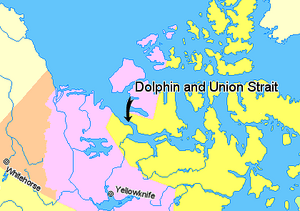Dolphin and Union Strait facts for kids
The Dolphin and Union Strait is a narrow stretch of water in northern Canada. It connects the mainland to Victoria Island. This strait is found in both the Northwest Territories and Nunavut. It is also a key part of the famous Northwest Passage. The strait links the Amundsen Gulf in the northwest to the Coronation Gulf in the southeast. It was named after two boats, the Dolphin and the Union. These boats were used by explorer John Richardson when he first explored the area in 1826.
Contents
The People of the Strait
Who Are the Copper Inuit?
The Inuit people who live in this area are known as the Copper Inuit. They are also sometimes called the "People at the end of the world." This is because very few other Indigenous groups lived in this specific region for a long time. Early explorers were very interested in the unique culture of the Copper Inuit.
Islands in the Strait
There are several islands within the Dolphin and Union Strait. These include the Liston and Sutton Islands. Historically, the Noahonirmiut band of Copper Inuit lived on these islands.
Geography and Wildlife
How Big is the Strait?
The Dolphin and Union Strait is about 161 kilometers (100 miles) long. Its width changes from 32 to 64 kilometers (20 to 40 miles).
Animals of the Strait
When the strait freezes over in winter, it becomes an important pathway. Barren-ground caribou use the ice to cross from the mainland to Victoria Island for the summer. They then return to the mainland for the winter. This group of caribou is known as the Dolphin and Union herd. You can also find Eider ducks living in the strait.
The local Inuvialuit people have special names for these animals. Caribou are called tuktu, a name understood by Inuit across the Arctic. Eider ducks are called kingalik, which means "big-nose."
Changes in the Environment
What's Happening to the Ice?
In recent years, the local Inuvialuit have noticed big changes. The average thickness of the winter sea ice has decreased a lot. In the 1960s, the ice was about 1.8 to 2.1 meters (6 to 7 feet) thick. Today, even in the middle of winter, it's only about 1.1 to 1.2 meters (110 to 120 centimeters) thick.
New Animals Arriving
People in the area are also seeing new types of animals. More flies and wasps are appearing. New kinds of birds are arriving that have never been seen before. Even grizzly bears are now roaming in areas where they used to be very rare. These changes show how the environment in the Arctic is shifting.


